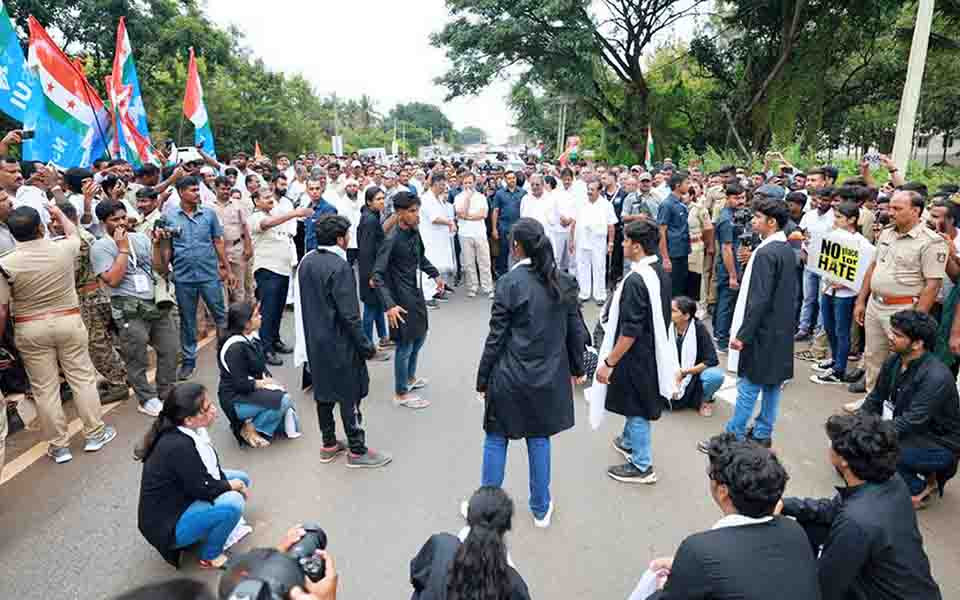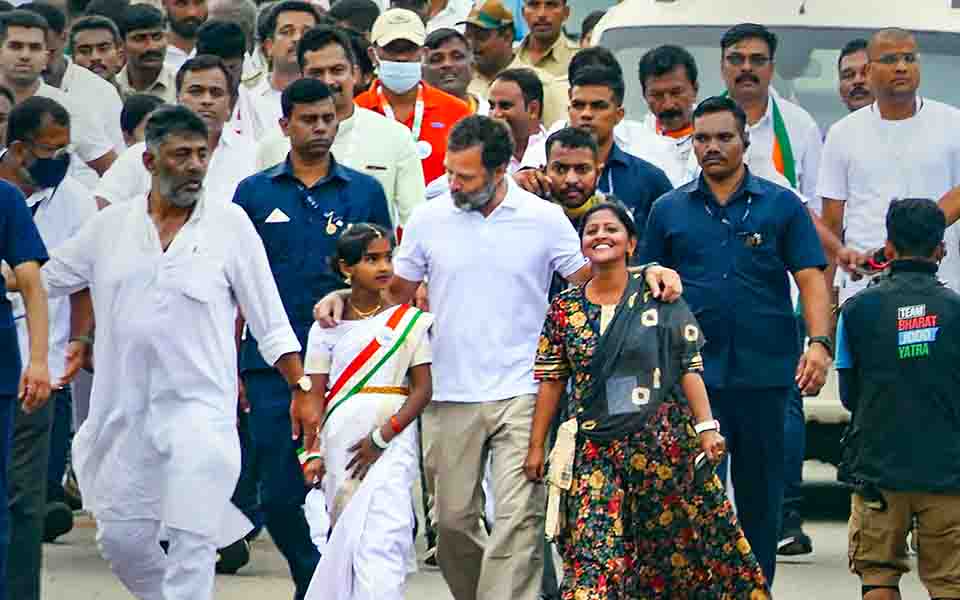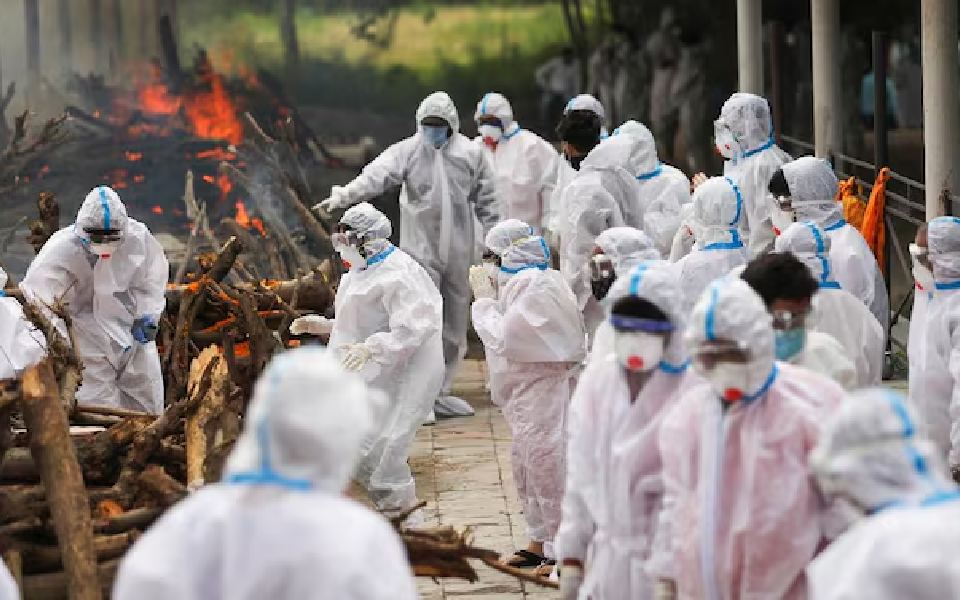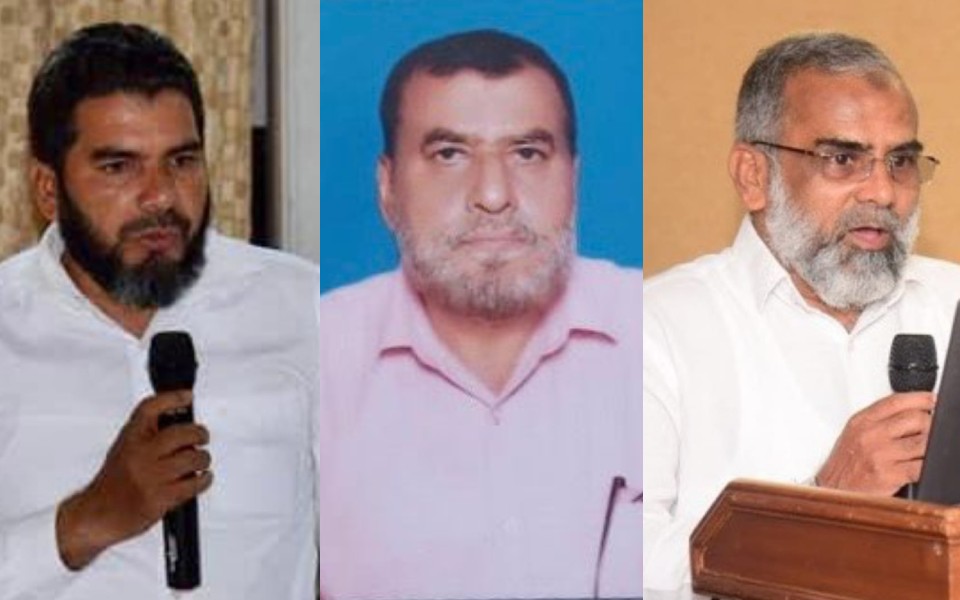Tumkur, Oct 9: Holding banners against "rising" unemployment and communal divide in society, a group of youths met Congress leader Rahul Gandhi on Sunday and joined him in the Bharat Jodo Yatra which, the party said, seeks to highlight their issues.
Gandhi said some political parties were trying to spread hatred in the country by misleading youngsters.
The former Congress president, who was accompanied by senior leader Siddaramaiah and Karnataka PCC president D K Shivakumar, interacted with many people, including children, women and a local singer, during his 20-km yatra on Sunday.
He appealed to the youth to join the yatra to spread the message of peace and brotherhood and unite India.
Sharing a picture of his interaction, Gandhi said these youths are saying that there is no room for hate in our beloved India.
"Why are the people of the country raising their voices against hatred? You all know it," he said.
The former Congress chief said a few years ago, the country did not have such an atmosphere as exists today.
"Earlier there was brotherhood, there was mutual love, but today it is not like this. And this is a big reason for the 'Bharat Jodo Yatra," he said in a Facebook post in Hindi.
Noting that the youth are the future of our country, he said, "They don't want hate, they want love, they want employment so that they can make the future of themselves, their family and country."
"Some political parties are misleading these youth, keeping them unemployed, for doing their hate politics," he said.
"We have to save the youth from going astray, create a better tomorrow for them, organise good education and employment," he said.
Gandhi said the Bharat Jodo Yatra is getting great support from the youth. "They are openly talking to me and I am listening to them. Our youth are so talented. Throwing them in the fire of hatred will destroy the future of the country."
Gandhi said people of every religion and every caste are walking together in the yatra, hand in hand, without asking each other's names.
If someone is left behind, people stop for him, if someone falls, people support him and pick him up, he noted.
"The beauty of this journey is its unity and integrity. Our India was like this before and we have to make that beautiful India again.
"We are all moving forward with the message of peace and people are continuing to join us. Come, let's raise the voice of these youth and unite India together," Gandhi said.

Tumakuru: Artists perform a street play as Congress leader Rahul Gandhi looks on during the party's 'Bharat Jodo Yatra', in Tumakuru district, Sunday | PTI Photo
Let the Truth be known. If you read VB and like VB, please be a VB Supporter and Help us deliver the Truth to one and all.
New Delhi, May 10 (PTI): India's cumulative excess mortality for 2020-2021 was 9.3 per cent higher than expected deaths, a figure which was lower than that of the US, Italy and Russia, official sources said, referring to the latest Civil Registration System (CRS) data.
Sources pointed out that the number of deaths documented in the CRS has been increasing over time, even in the years preceding the COVID-19 outbreak in 2020, they said.
The excess mortality is the additional number of deaths, due to all causes during a crisis such as COVID-19, above the number of deaths expected to be reported during "normal" conditions.
The annual increment observed in a given year, compared to the previous year, has varied from 1.3 per cent in 2016 to 9.93 per cent in 2019, with the average increase over three preceding years (2016 to 2019) estimated at 6.42 per cent per annum.
The annual secular increase in deaths registered in CRS can be attributed to several reasons, including a larger population cohort, maturing reporting processes and increased awareness of the need for registration, leading to higher registration levels, sources said.
The annual secular increase is the long-term, consistent increase in deaths over a year.
This trend has been further accentuated over the years by the mandatory requirements for death certificates linked to pension schemes, social security benefits, and property issues. Besides, COVID-19 death compensation required death certification, prompting registration under CRS, the sources stated.
"Our teams conducted preliminary analyses of CRS data to assess cumulative excess deaths in the years 2020 and 2021," an official source said.
Based on the three-year (2016-19), annual rate of increase of 6.42 per cent mentioned above, the expected number of deaths would be 81,31,869 in 2020 and 86,54,185 in 2021.
However, the observed deaths were 81,15,882 in 2020 and 1,02,24,506 in 2021.
The excess deaths, defined as observed minus expected deaths, were (-)15,987 and 15,70,321, respectively, the source said.
"Thus, the total excess deaths over the two-year period amounted to 15,54,334. As a percentage, this is 9.3 per cent higher than the expected deaths. This translates into about 1,249 excess deaths per one million population," the source said.
It must be emphasised that excess deaths in these years are not equal to COVID-19 direct deaths, the source underlined.
These excess deaths include reported COVID-19 deaths (4,81,080 by the end of 2021), unreported COVID-19 deaths, deaths due to all other causes, and possible indirect effects of COVID-19.
"To benchmark these estimates, subject to more nuanced future analyses, we compared cumulative excess deaths in India for 2020 and 2021 with those of selected countries that provide publicly available data on excess mortality during the same period," the source said.
Excess mortality in high-income countries, expressed as a percentage higher than the expected mortality, was found to be 17.6 per cent in the US, 11.8 per cent in Italy, 11.6 pcer cent in the UK, 29.9 per cent in Russia, 6.7% in France, 5.3 per cent in Germany, and 5.2% in Canada.
Excess mortality in middle-income countries was 43.6% in Mexico and 12.6% in Brazil. The corresponding figure for India was 9.3%, as stated above.
"When expressed differently, India's 1,249 excess deaths per one million were much lower than in the USA (3,021 per million), Italy (2,573), the UK (1,874), France (1,281), Russia (7,240), Mexico (5,217), and Brazil (1,820), but somewhat higher than that of Canada (825) and Germany (1,214)," the source said.
In the past, reports of exorbitantly high excess deaths in India during 2020 and 2021, based on modelling methodology, have emerged in the public domain, sources said.
A WHO report estimated India's excess deaths at 47 lakhs. Another report in a top journal cited a figure of about 41 lakh excess deaths in this period.
The CRS data of the actually counted deaths at a high reporting rate, after accounting for secular increase, yield a much lower estimate of 15,54,334, as elaborated above.
"India mounted a whole-of-government and whole-of-society response to the pandemic emergency. The strategy comprised five science-driven tools: testing, suppressing chains of transmission, clinical care, safe behaviour, and vaccination.
"The virus was ultimately defeated by the made-in-India vaccines, with over 220 crore doses administered in the world's largest vaccination program," another official source said.
Of these, as many as 145 crore doses were administered in 2021 alone. It has been reported in the Lancet that the COVID-19 vaccination program in Bharat in 2021 itself saved 34 lakh lives, the source said.
The Civil Registration System (CRS) in India is a compulsory, independent, and universal system for recording all births and deaths under the Registration of Births and Deaths Act, 1969. These events are reported to the local registrar, based on which each state generates its respective report.
The collated data from state reports are published as the annual vital statistics report by the Registrar General of India (RGI).





